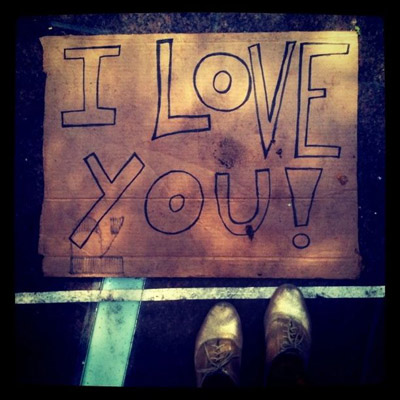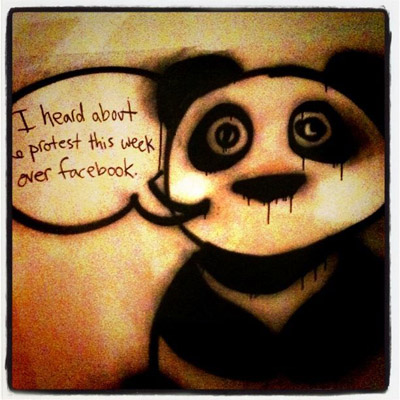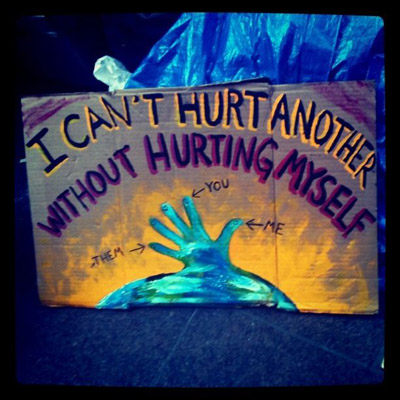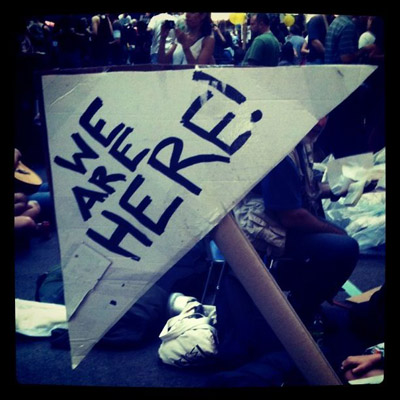Occupy Everywhere: The Language of the Occupation
EDITOR’S NOTE: This is the second installment of musician, activist and citizen journalist Kim Boekbinder’s ongoing series for Coilhouse, “Occupy Everywhere”. Click here to read her introduction. Don’t miss Jeff Wengrofsky’s recent essay, “The Praise of Motherfuckers“, either. The blog’s #OWS scrapbook post is also being updated periodically with new links and pertinent clippings.

All photos and video in this post provided by Kim Boekbinder.
On Speech
The participants of Occupy Wall Street have been denied the use of any amplification instruments – no microphones, no loudspeakers. So, to amplify a speech, they use “The People’s Mic”, a technique in which short sentences are repeated in waves (called “generations”) through the audience, sending the message further than the reach of one human voice.
It is quite powerful. It means the audience is listening carefully to learn what they will be repeating, then they repeat clearly what has been said. And because everything is repeated you hear each thing 2-4 times. Repetition has been a powerful pedagogical tool for a long time for a reason: our relationship to words changes when we use them ourselves.
The People’s Mic falls over sometimes, speech gets garbled, speakers get carried away and forget to wait for all the generations to iterate before starting their next line, but the mic is easily recalibrated when this happens.
The technique forces speeches to be made in short bursts which are easily articulated and quick to repeat. There is a rhythm, an art. It feels good to be part of the speech, to be repeating the sentences so that others can hear. We are all in this together. My favorite part is when the speaker introduces themselves.
“My name is Katie.” says the speaker.
“My name is Katie.” First generation of voices.
“My name is Katie.” Second generation of voices.
The weakness of The People’s Mic is that speeches are chopped up into bite size morsels which tend to sound extra “revolutionary.” Everything sounds like a big, epic, shouty thing. And the complex topics, the nuances of the Occupation, cannot be expressed easily in two to three word bursts. Taken as the sparks that are meant to begin conversations the speeches are wonderful: we all heard it, we all said it. Whether we agree or not we can now continue the discussion in smaller groups.
New amplification techniques will need to be found as the crowds grow and split, but for now it’s a great triumph over adversity. And it’s fun.
On Hand Signals
When the General Assembly meets the people use hand signals to convey how they feel about what is being said. The use of hand signals allows the speaker to continue talking without interruption, though the audience is still communicating their approval or disagreement.
Wiggling your fingers to display your agreement with a serious political issue feels silly, but this is a movement that is not afraid to be silly. Have you seen “Occupy Sesame Street”? It’s hilarious. Making fun of your own movement is an amazing tactic. Occupy Wall Street is very serious, but it also has a sense of humor. And who wants a revolution without laughter?


The dedication to nonviolence extends to much of the language of OWS. While there are plenty of signs that use violence – “Kill the rich.” “Eat the rich.” “Fuck Wall Street.” – there are more signs that display intelligent demands, straight facts, or messages of caring and love. One woman had a sign that read “Save the 99%.” But she had since crossed out the 99 and replaced it so the sign now reads “Save the 100%.”
And while there is a lot of anger, and a sense of entitlement to an American Dream that many feel they were promised, there is also the feeling that we’re building a better world for everyone. Including the 1%.





I’ll be interested in seeing how the language of the Occupation changes from city to city, and how the language changes over time. I personally hope for more coherent and nonviolent messages that may gather more support for the movement. But for now, everyone is free to put whatever they want on their sign.
Further studies:
- In this Youtube video, Occupiers say what they want.
- Douglas Rushkoff on CNN “Think Occupy Wall St. is a phase? You don’t get it.”
- Laurie Penny’s thoughts on the Occupation.

October 11th, 2011 at 6:20 pm
(!!) I cant decide if the people’s microphone is inspiring or terrifying.
October 13th, 2011 at 5:02 am
it’s actually an ancient technique for speaking to larger crowds than your voice will carry to. for instance, julius caesar gave speeches to his army that way. (although in his case, there were just individual repeaters, not the whole crowd) with all those people, someone having the idea isn’t very surprising to me, but convincing enough people to try it even the first time- without a megaphone to make your ideas sound important- is pretty impressive.
October 13th, 2011 at 3:11 pm
[…] Clooney really parlayed his star power into the sphere of politics? Would the opposing parties occupying Wall Street both decamp? Or would the dreamboat be swift-boated for sinking the ship in The Perfect Storm […]
October 14th, 2011 at 11:56 am
I knew The People’s Mic must have historical origins, I’ve never seen it before and it is both strange and neat. For now it’s a great tool, but if it becomes a fetish it will undermine the assemblies’ power. I know that other General Assemblies are using amplification which I think is a much better way to communicate to a crowd. Plus I think it will just get really creepy if we only address each other in little shouty snippets.